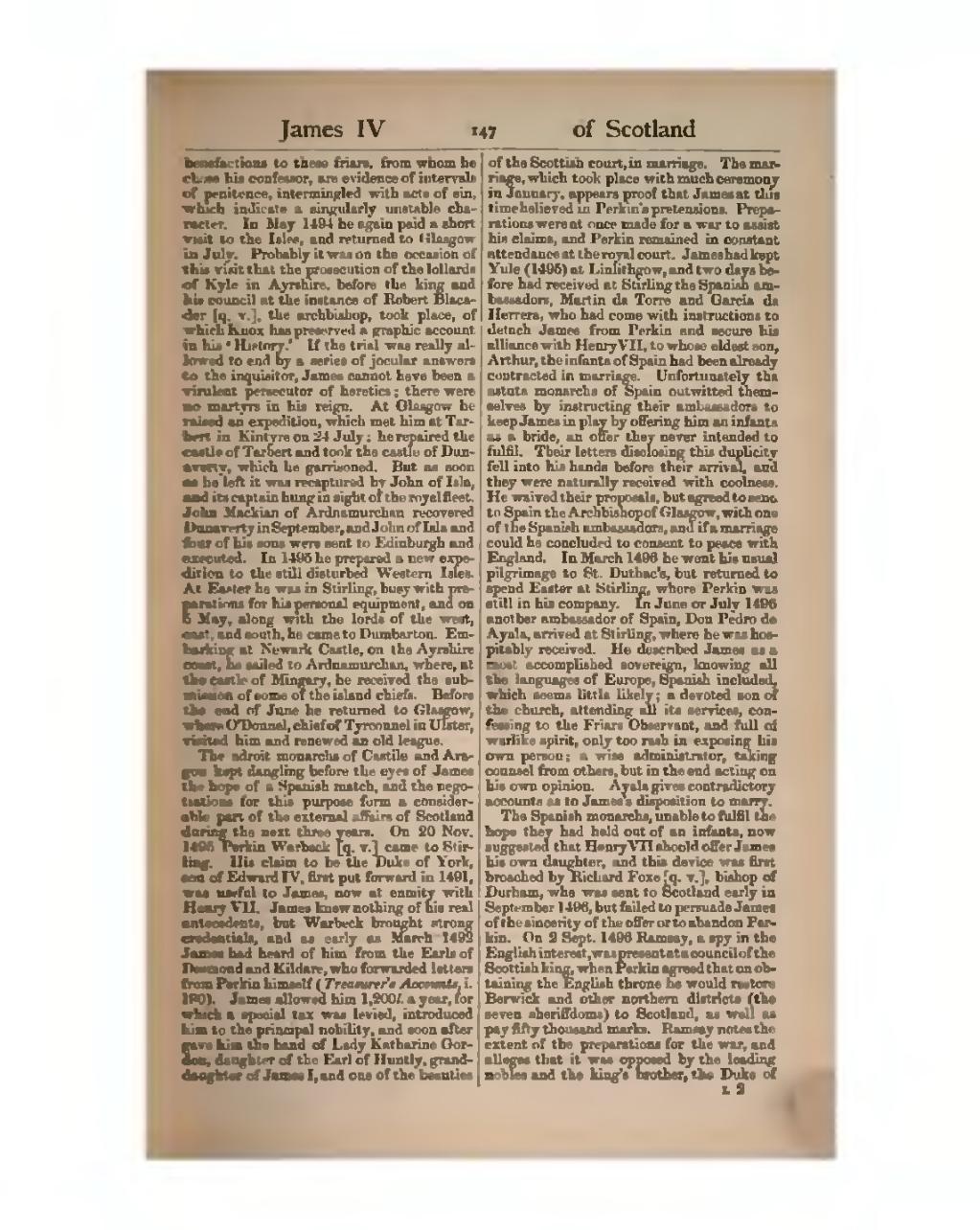benefactions to these friars, from whom he chose his confessor, are evidence of intervals of penitence, intermingled with acts of sin, which indicate a singularly unstable character. In May 1494 he again paid a short visit to the Isles, and returned to Glasgow in July. Probably it was on the occasion of this visit that the prosecution of the lollards of Kyle in Ayrshire, before the king and his council at the instance of Robert Blacader [q. v.], the archbishop, took place, of which Knox has preserved a graphic account in his ‘History.’ If the trial was really allowed to end by a series of jocular answers to the inquisitor, James cannot have been a virulent persecutor of heretics; there were no martyrs in his reign. At Glasgow he raised an expedition, which met him at Tarbert in Kintyre on 24 July; he repaired the castle of Tarbert and took the castle of Dunaverty, which he garrisoned. But as soon as he left it was recaptured by John of Isla, and its captain hung in sight of the royal fleet. John Mackian of Ardnamurchan recovered Dunaverty in September, and John of Isla and four of his sons were sent to Edinburgh and executed. In 1495 he prepared a new expedition to the still disturbed Western Isles. At Easter he was in Stirling, busy with preparations for his personal equipment, and on 5 May, along with the lords of the west, east, and south, he came to Dumbarton. Embarking at Newark Castle, on the Ayrshire coast, he sailed to Ardnamurchan, where, at the castle of Mingary, he received the submission of some of the island chiefs. Before the end of June he returned to Glasgow, where O'Donnel, chief of Tyrconnel in Ulster, visited him and renewed an old league.
The adroit monarchs of Castile and Aragon kept dangling before the eyes of James the hope of a Spanish match, and the negotiations for this purpose form a considerable part of the external affairs of Scotland during the next three years. On 20 Nov. 1495 Perkin Warbeck [q. v.] came to Stirling. His claim to be the Duke of York, son of Edward IV, first put forward in 1491, was useful to James, now at enmity with Henry VII. James knew nothing of his real antecedents, but Warbeck brought strong credentials, and as early as March 1492 James had heard of him from the Earls of Desmond and Kildare, who forwarded letters from Perkin himself (Treasurer's Accounts, i. 190). James allowed him 1,200l. a year, for which a special tax was levied, introduced him to the principal nobility, and soon after gave him the hand of Lady Katharine Gordon, daughter of the Earl of Huntly, granddaughter of James I, and one of the beauties of the Scottish court, in marriage. The marriage, which took place with much ceremony in January, appears proof that James at this time believed in Perkin's pretensions. Preparations were at once made for a war to assist his claims, and Perkin remained in constant attendance at the royal court. James had kept Yule (1495) at Linlithgow, and two days before had received at Stirling the Spanish ambassadors, Martin de Torre and Garcia de Herrera, who had come with instructions to detach James from Perkin and secure his alliance with Henry VII, to whose eldest son, Arthur, the infanta of Spain had been already contracted in marriage. Unfortunately the astute monarchs of Spain outwitted themselves by instructing their ambassadors to keep James in play by offering him an infanta as a bride, an offer they never intended to fulfil. Their letters disclosing this duplicity fell into his hands before their arrival, and they were naturally received with coolness. He waived their proposals, but agreed to send to Spain the Archbishop of Glasgow, with one of the Spanish ambassadors, and if a marriage could be concluded to consent to peace with England. In March 1496 he went his usual pilgrimage to St. Duthac's, but returned to spend Easter at Stirling, where Perkin was still in his company. In June or July 1496 another ambassador of Spain, Don Pedro de Ayala, arrived at Stirling, where he was hospitably received. He described James as a most accomplished sovereign, knowing all the languages of Europe, Spanish included, which seems little likely; a devoted son of the church, attending all its services, confessing to the Friars Observant, and full of warlike spirit, only too rash in exposing his own person; a wise administrator, taking counsel from others, but in the end acting on his own opinion. Ayala gives contradictory accounts as to James's disposition to marry.
The Spanish monarchs, unable to fulfil the hope they had held out of an infanta, now suggested that Henry VII should offer James his own daughter, and this device was first broached by Richard Foxe [q. v.], bishop of Durham, who was sent to Scotland early in September 1496, but failed to persuade James of the sincerity of the offer or to abandon Perkin. On 2 Sept. 1496 Ramsay, a spy in the English interest, was present at a council of the Scottish king, when Perkin agreed that on obtaining the English throne he would restore Berwick and other northern districts (the seven sheriffdoms) to Scotland, as well as pay fifty thousand marks. Ramsay notes the extent of the preparations for the war, and alleges that it was opposed by the leading nobles and the king's brother, the Duke of
